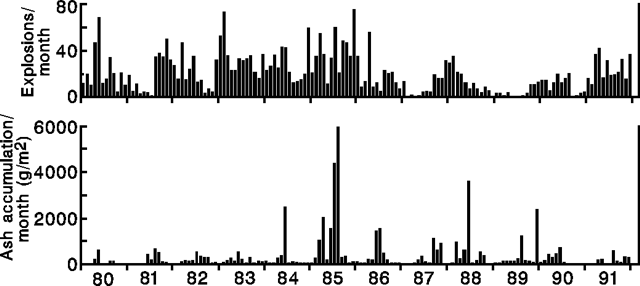Report on Aira (Japan) — December 1991
Bulletin of the Global Volcanism Network, vol. 16, no. 12 (December 1991)
Managing Editor: Lindsay McClelland.
Aira (Japan) More frequent explosions and stronger seismicity
Please cite this report as:
Global Volcanism Program, 1991. Report on Aira (Japan) (McClelland, L., ed.). Bulletin of the Global Volcanism Network, 16:12. Smithsonian Institution. https://doi.org/10.5479/si.GVP.BGVN199112-282080
Aira
Japan
31.5772°N, 130.6589°E; summit elev. 1117 m
All times are local (unless otherwise noted)
The number of explosions . . . increased . . . to 37 in December (figure 17), bringing the 1991 total to 295, the highest since 474 explosions were recorded in 1985. The December 1991 activity deposited 266 g/m2 of ash [at KLMO] . . . . An explosion at 1742 on 16 December produced the month's highest ash cloud, which rose more than 3 km above the crater. The air shock from an explosion on 5 December at 1246 broke a glass door; no other damage was reported. Similar eruptive activity continued through mid-January, adding 15 explosions by the 17th. Seismicity was more vigorous than usual during December. Swarms of volcanic earthquakes were recorded on 1, 3, 16, 17, 21-27, and 29 December.
 |
Figure 17. Monthly number of explosions (top) and ash accumulation 10 km W of the crater (bottom) at Sakura-jima, 1980-1991. Courtesy of JMA. |
Geological Summary. The Aira caldera in the northern half of Kagoshima Bay contains the post-caldera Sakurajima volcano, one of Japan's most active. Eruption of the voluminous Ito pyroclastic flow accompanied formation of the 17 x 23 km caldera about 22,000 years ago. The smaller Wakamiko caldera was formed during the early Holocene in the NE corner of the caldera, along with several post-caldera cones. The construction of Sakurajima began about 13,000 years ago on the southern rim and built an island that was joined to the Osumi Peninsula during the major explosive and effusive eruption of 1914. Activity at the Kitadake summit cone ended about 4,850 years ago, after which eruptions took place at Minamidake. Frequent eruptions since the 8th century have deposited ash on the city of Kagoshima, located across Kagoshima Bay only 8 km from the summit. The largest recorded eruption took place during 1471-76.
Information Contacts: JMA.

